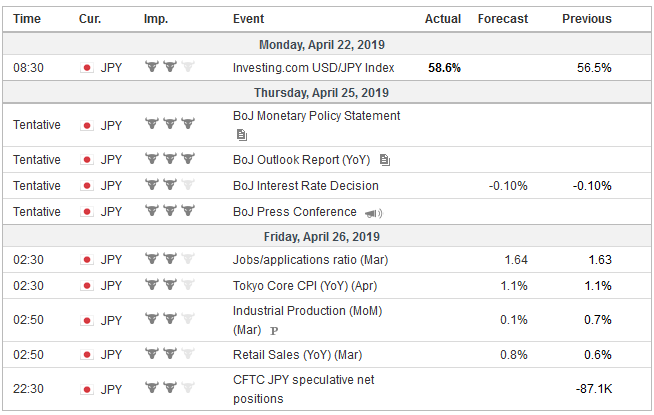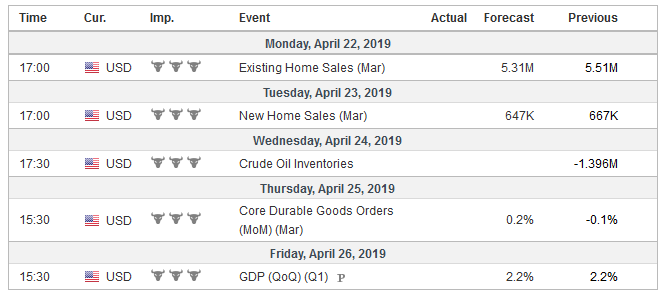The divergence thesis that drives our constructive outlook for the dollar received more support last week than we expected. A few hours after investors learned that Japan’s flash PMI remained below the 50 boom/bust level, Europe reported disappointing PMI data as well. And a few hours after that the US reported that retail sales surged in March by the most in a year and a half (1.6%). This coupled with the new cyclical low in weekly jobless claims boosted GDP forecasts, quieted the recession talk. With some markets closed on Monday, the week not only will have a slow start but the potential to change the investment climate is low. The US earnings season continues with some favorites like Amazon, Facebook, Twitter,
Topics:
Marc Chandler considers the following as important: 4) FX Trends, Australia, Bank of Japan, Brexit, Canada, China, Featured, newsletter, US
This could be interesting, too:
Nachrichten Ticker - www.finanzen.ch writes Die Performance der Kryptowährungen in KW 9: Das hat sich bei Bitcoin, Ether & Co. getan
Nachrichten Ticker - www.finanzen.ch writes Wer verbirgt sich hinter der Ethereum-Technologie?
Martin Hartmann writes Eine Analyse nach den Lehren von Milton Friedman
Marc Chandler writes March 2025 Monthly
The divergence thesis that drives our constructive outlook for the dollar received more support last week than we expected. A few hours after investors learned that Japan’s flash PMI remained below the 50 boom/bust level, Europe reported disappointing PMI data as well. And a few hours after that the US reported that retail sales surged in March by the most in a year and a half (1.6%). This coupled with the new cyclical low in weekly jobless claims boosted GDP forecasts, quieted the recession talk.
With some markets closed on Monday, the week not only will have a slow start but the potential to change the investment climate is low. The US earnings season continues with some favorites like Amazon, Facebook, Twitter, and Microsoft on tap. Boeing also reports and some economists see the grounding of the 737 Max and production cuts shaving US Q2 GDP by a 0.2%-0.3% through slower equipment spending and exports. At the end of the week, S&P reviews Greece and Italian debt. Italy’s rating will likely be kept at BBB, where both Moody’s and Fitch also are. There is a reasonable chance that Greece’s rating is revised up from the current B+. S&P has a positive outlook for Greece. It would be a catch-up move as Fitch already put Greece at BB- last August (with a stable outlook).
We provide a thumbnail sketch of the six events that will command attention. Two major central banks meet (Bank of Japan and the Bank of Canada). There are two big data points (US Q1 GDP and Australia Q1 GDP). There are two official events as the UK Parliament returns from the vacation and Brexit remains the focus though May 2 local elections will steal some attention and US-China trade talks resume.
JapanBank of Japan: Governor Kuroda indicated recently that the BOJ could provide additional easing if the price gains lost momentum. This seems to be a bluff. For more than a year now, Kuroda has slowed the pace of bond purchases. In fact, catching the market by surprise, it the BOJ announced before the weekend that it would reduce the among of long-term bonds it will purchase, for the first time in a few months. There seems to be little appetite for a deeper cut in the minus 10 bp deposit rate or the zero target of the 10-year benchmark yield (capped at 20 bp). The Japanese economy stagnated in H2 18, and the economy may have contracted in Q1 19. The all-industries index is a proxy for GDP, and after falling by 0.2% in January, it is expected to have fallen by 0.1% in February and will be reported before the BOJ meets. Exports fell for four consecutive months through March. Core inflation, which the BOJ targets, excludes fresh food, stood at 0.8%. It peaked at 1.0% last September and October. Operationally, the closure of the local markets and settlement for ten days later this month for the ascension of the new Emperor will likely require massive injections of liquidity, which could weigh on the yen. Kuroda wants to project a central bank with tools and will at its disposal, but it seems increasingly exhausted. The BOJ may reduce outlook for exports and production. Trade talks with the US pick up with Prime Minister Abe in Washington at the end of next week with Finance Minister Aso. North Korea’s test of a new tactical weapon will likely also be on the agenda. |
Economic Events: Japan, Week April 22 |
CanadaBank of Canada: The neutral stance will be maintained. The economic data is sufficiently mixed to allow the officials to be patient and monitor developments. Extrapolating the overnight swaps index, the market is pricing less than a one-in-five chance of a rate cut in the next six months. Canada faces two immediate economic challenges. First, which is well known, is the housing market in the Toronto and Vancouver regions. The second is that its non-oil exports have fallen to their lowest level in a year, with a 4% decline in February. Overall, exports are off 6% from the record highs set last July. The new provincial government in Alberta will reverse the current policies and boost the output. Employment growth remains robust, averaging 30k over the past six months, which is comparable to the US adding 300k a month and nearly twice the 12-month average. Consumption has softened, but gain in February retail sales (0.8% which was twice the median forecast in the Bloomberg survey) snapped a three-month drop. |
Economic Events: Canada, Week April 22 |
United StatesUS Q1 GDP: The government shutdown, the unusually cold weather, and what seems to be a typical pattern for weakness in Q1, coupled with the dramatic decline in the equity prices in Q4 18 (and the knock-on impact from the wealth effect) depressed expectations for growth at the start of the year. It looked like the economy was stagnating or worse. The inversion of parts of the yield curve was seized upon as further evidence that the end of the expansion was at hand. The Atlanta Fed’s GDPNow tracker began the quarter with a 0.3% projection and, after the retail sales report, stands at 2.8%. The median economist forecast according to Bloomberg is 2.2%, which would match the Q4 18 pace. Some economists have a more dour estimate of 1.5%. We are neither as optimistic as the Atlanta Fed nor as pessimistic as the naysayers. Our expectation is for around 2% growth. The report is released at the end of the week and a few days before the May 1 FOMC meeting. There is little chance of a change in policy, but it would appear that some of the cross-currents that had concerned Powell & Co have abated. |
Economic Events: United States, Week April 22 |
United KingdomBrexit: Parliament returns from its holiday recess, and the Brexit debate will be taken up again. However, the immediate focus is on the local elections that will be held on May 2. Although the Tories have made a mess of Brexit from the get-go, Labour’s agenda and rhetoric estrange voters and prevents it from truly capitalizing on the situation, though some polls have just begun showing Labour edging ahead. If the UK is to leave the EU, their other commitments (see Good Friday Agreement) circumscribes their degrees of freedom, and some form of a customs union arrangement continues to be the most likely. Meanwhile, the UK economy appears to be relatively well. Employment growth is strong and retail sales jumped 1.1% in March. Retail sales rose by an average of 0.8% a month in Q1 19 after a flat average in Q4 18 and a 0.3% average gain in Q3 18. The manufacturing sector that is contracting in the eurozone (PMI) is surging in the UK. The 0.9% rise in February manufacturing output followed a 1.1% gain in January. The two-month average is the strongest since the end of 2016. |
Economic Events: United Kingdom, Week April 22 |
Australia Q1 CPI: The market continues to favor a rate cut by the Reserve Bank of Australia later this year. The forward rate implies about a 31 bp easing in rates by year-end, while the overnight index swaps are consistent with around a 75% chance of a cut. Yet recent data have been robust, with the composite PMI moving back above 50 and full-time jobs growth averaging 37k a month in Q1, the most since July 2017. Chinese officials appear committed to strengthening the economy, and Australia is often seen as a proxy of sorts for China. The quarterly CPI matched the four-year peak of 2.1% in Q2 18 and has eased since. Headline CPI is expected to have slowed for its third consecutive quarter in Q1 19. Prices are expected to have risen by 0.2% in the first three months of the year for a 1.5% year-over-year pace, down from 1.8% in Q4. The underlying rates (trimmed mean and the weighted median) are also expected to have slowed. The easing of price pressures gives the RBA scope to cut when the economic outlook justifies it. Based on the current information set, we pencil in a cut in late Q3.
US-China Trade Talks: Officials continue to assure investors that progress is being made in the trade talks between the world’s two largest economies. US Trade Representative Lighthizer is headed to Beijing later this month, while Vice Premier Liu will return to the US in early May. Late May has long been identified as a possible timeframe for the two leaders to meet. China has already reportedly stepped up its purchases of soy and swine from the US. Much of US demands appear to have been agreed upon by China, but rather than this being a result of the savvy American negotiators, it seems that China was moving in this direction, with the help of past American and European pressure, as well as, most importantly, its internal dynamics. The dollar depreciated by about 10% against the yuan in 2017, when it fell against most currencies. It recouped these losses last year, largely in line with its broader performance and returned toward CNY7.00 area. The yuan has strengthened against the dollar this year. Its 2.4% appreciation makes it among the strongest currencies in the world, behind the Russian rouble’s 8.8% gain and three Latam currencies (Chilean peso up 4.7%, the Mexican peso up 4.6%, and the Colombian peso, which has risen 2.8%). It is not clear what commitments the US is making. Treasury Secretary Mnuchin seemed to accede to the Chinese demand that the enforcement mechanism is two-way, fair, equal, acknowledging that China may be in its rights to act if the US fails to live up to its commitments. That said, it might be more convincing for many if Lighthizer were to make a similar commitment.
Tags: Australia,Bank of Japan,Brexit,Canada,China,Featured,newsletter,US




